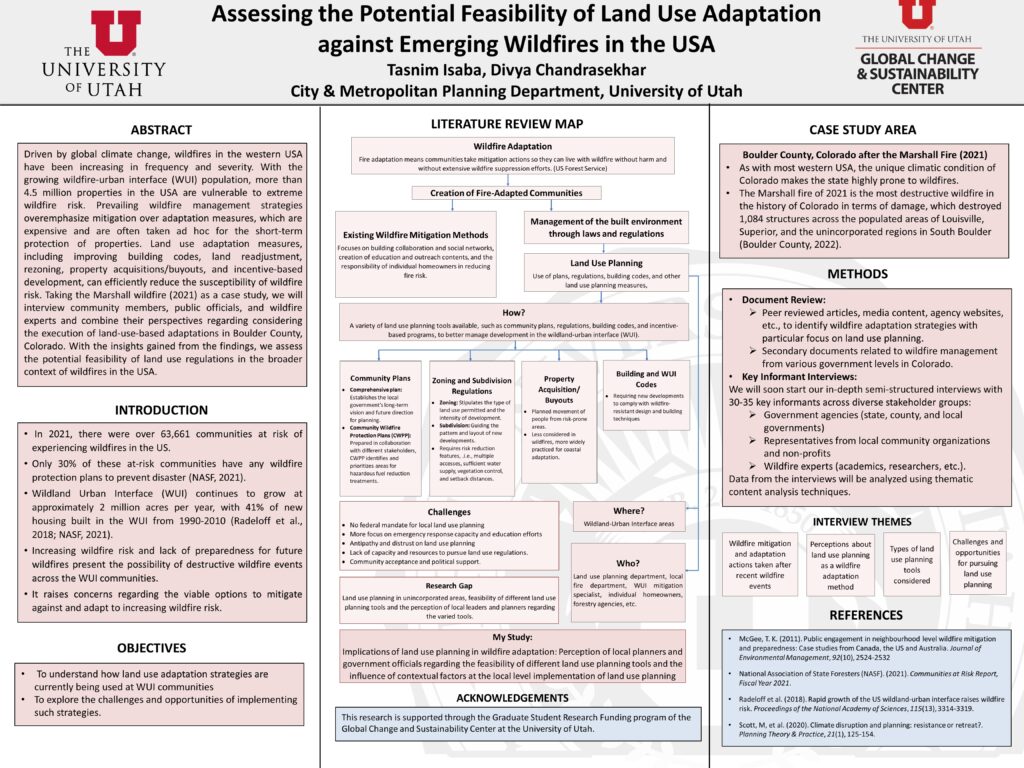Assessing the Potential Feasibility of Land Use Adaptation against Emerging Wildfires in the USA: A Case Study of Marshall Wildfire, Colorado
[bs_collapse id=”collapse_b003-f2ec”]
[bs_citem title=”Bio” id=”citem_95b0-4c38″ parent=”collapse_b003-f2ec”]
I am currently a Ph.D. student at the City & Metropolitan Planning Department of the University of Utah. I am passionate about hazard research and conducting community-engaged work based on at-risk communities. I completed my Bachelor’s and Master’s from the Bangladesh University of Engineering and Technology in Dhaka, Bangladesh, before coming here. Currently, I am working as a Graduate Research Assistant (RA) under my supervisor, Dr. Divya Chandrasekhar, for an NSF-funded project titled “Stakeholder Interdependencies in Post-Disaster Relocation under High Uncertainty.” As my dissertation, I am working on wildfire adaptation strategies and the potential of using land-use adaptation measures as viable options to improve the Wildland-Urban Interface (WUI) communities.
[/bs_citem]
[bs_citem title=”Abstract” id=”citem_72e2-3e05″ parent=”collapse_b003-f2ec”]
Driven by global climate change, wildfires in the western USA have been increasing in frequency and severity. With the growing wildfire-urban interface (WUI) population, more than 4.5 million properties in the USA are vulnerable to extreme wildfire risk. Prevailing wildfire management strategies overemphasize mitigation over adaptation measures, which are expensive and are often taken ad hoc for the short-term protection of properties. Land use adaptation measures, including improving building codes, land readjustment, rezoning, property acquisitions (buyouts), and incentive-based development, can efficiently reduce the susceptibility of wildfire risk. Taking the Marshall wildfire (2021) as a case study, we will interview community members, public officials, and wildfire experts and combine their perspectives regarding considering the execution of land-use-based adaptations in Boulder County, Colorado. With the insights gained from the review and fieldwork, we assess the potential feasibility of land use regulations in the broader context of wildfires in the USA.
[/bs_citem]
[bs_citem title=”Narrative” id=”citem_adfe-1af9″ parent=”collapse_b003-f2ec”]
Driven by climate change, wildfire events will likely occur at a greater frequency and severity in the western USA. With the growing development in Wildland-Urban Interface areas and the increased cost of wildfires, we need to re-shift our focus from traditional measures and think about alternatives. Land use planning, including imposing building codes and guiding future development, can help the communities to balance wildfire risk. The study will assess the perception of wildfire-affected communities in Boulder, Colorado, in initiating land use measures as a potential adaptation strategy.
[/bs_citem]
[/bs_collapse]

